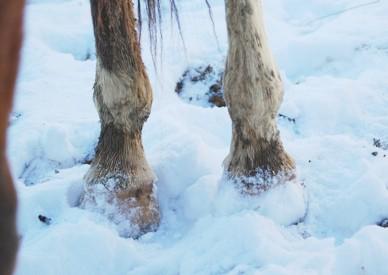When Winter Laminitis Strikes Out of Nowhere
For the insulin resistant horse, winter laminitis can strike seemingly out of nowhere, with no change in diet or management and some puzzling inconsistencies. The horse may not necessarily have a prior history of laminitis. The pain is often severe, but the feet aren’t hot as they are in classical acute laminitis cases. The digital pulses may or may not be elevated. Radiographs tend to remain stable in most cases; without major changes with rotation or sinking. NSAIDs (Non-Steroidal Anti-Inflammatories) like phenylbutazone, which are commonly used any time there is foot pain similar to this, have no positive effect.
It can be confusing when the horse looks like a typical laminitis case but without the heat and high pulses. Inadequate blood supply is the perfect explanation. The body’s normal response to cold is to constrict blood vessels in the periphery to reduce heat losses but in IR horses the reaction appears to be exaggerated. This is because of the well-documented role of the potent vasoconstrictor endothelin-1 in IR horses, with the most recent study confirming that endothelin-1 is involved with laminitis because of elevated blood insulin.
With normal insulin sensitivity inside a blood vessel, the endothelial cells produce nitric oxide and dilate when exposed to insulin. However if the cells are insulin resistant and not responsive to insulin, they constrict under the influence of endothelin-1. A normal horse, with normal circulation, can adapt to the cold and will open and close vessels for circulation before they reach a critical low oxygen level. IR horses have pre-existing damage to the circulation in the feet and there are higher levels of endothelin-1. Cold triggers a reduced blood supply severe enough to cause pain.
Relief is rapid if you warm the feet and legs and support circulation
Protection against the cold is therefore the first step in combating winter related hoof pain. Horses should be protected from high winds, rain and snow. They should be blanketed and wear leg wraps and lined boots to warm the lower legs.
This helps, but for some horses is not enough. If your horse ends up with laminitis, even after blanketing and wrapping, supplements to enhance blood flow may help. Herbal products known as “adaptogens” promote healthy stress responses and may be very beneficial.
- Jiaogulan (Gynostemma pentaphyllum) is a good one to use because it also strongly supports vascular nitric oxide production, which improves blood delivery to the extremities and feet.
- The amino acid arginine, as well as citrulline may also be very beneficial in promoting good blood flow to the hoof. Arginine is the precursor to nitric oxide, which is a vasodilator. Citrulline is converted to arginine after absorption.
- Taurine has been found in a recent study to improve insulin sensitivity. L-glutamine is also useful to support antioxidant glutathione and carnitine derivatives to support horses with neuropathic pain and help with insulin sensitivity.
Uckele Health & Nutrition, maker of CocoSoya®, offers products that address laminitis in IR horses.
Glycocemic EQ promotes healthy, balanced glucose metabolism, nerve function and insulin sensitivity.
Jiaogulan supports healthy vascular function to promote circulation and structural hoof health.
Laminox promotes healthy circulation and metabolic balance. With Arginine and Jiaogulan to promote healthy blood flow.
Taurine is an amino acid that provides support for calming and mental focus, as well as for heart and muscle function.
About Dr. Kellon
Dr. Eleanor Kellon, staff veterinary specialist for Uckele Health & Nutrition, is an established authority in the field of equine nutrition for over 30 years, and a founding member and leader of the Equine Cushings and Insulin Resistance (ECIR) group, whose mission is to improve the welfare of horses with metabolic disorders via integration of research and real-life clinical experience. Prevention of laminitis is the ultimate goal. www.ecirhorse.org
Uckele Health & Nutrition is an innovation-driven health company committed to being on the leading edge of nutritional science and technology for over 50 years. Uckele takes pride in formulating and manufacturing a full spectrum of quality nutritional supplements incorporating the latest nutritional advances for equine athletes and companion animals to help achieve optimal health. www.uckele.com











